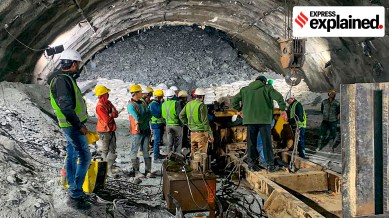A tunnel-in-a-tunnel: How the new method to rescue trapped workers in Uttarakhand will work
Trying to dig a way to the 40 workers trapped for more than three days is not working because falling debris is blocking the path even as it is being cleared. Rescuers will now try a ‘trenchless’ technique, burrowing underground using a ‘horizontal auger machine’ and laying pipes for the workers to crawl through

More than 72 hours after the under-construction tunnel on the Yamunotri National Highway in Uttarakhand’s Uttarkashi district collapsed, rescuers tried a new way to reach the 40 workers trapped inside — burrowing horizontally underground without disturbing the loose rock and debris on the surface.
Attempts to smash through the pile of rubble using large digging and earth-moving equipment have not succeeded as the loose, almost crumbly, rock continues to fall, blocking the passage with fresh debris even as a path to the workers is being cleared. By Monday night, heavy excavator machines had removed around 21 metres of loose debris, but new debris showers had undone a third of the work, restricting the progress to only 14 metres.
Uttarakhand Secretary (Disaster Management) Ranjit Sinha said this will be the first time that a “tunnel inside a tunnel” will be created as part of a rescue operation in India. He expressed confidence that there is a “more than 90 per cent chance” that the plan will work.
Trenchless technique and mild steel pipes
Trenchless technology refers to a set of construction methods used to install, repair, or rehabilitate underground infrastructure without the need for extensive excavation or open trenches. This minimises surface disruption, reduces the environmental impact, and often produces results sooner and more cost-effectively compared with traditional digging methods.
Trenchless techniques are extensively used in sewage systems, including for installation, repair, and rehabilitation. The technique can also be valuable in tunnel collapse rescue operations to access and rescue individuals trapped underground without exacerbating the collapse or causing further harm.
In this case, the trenchless method will be used for horizontal directional drilling, that is, to drill a tunnel horizontally underground using an auger machine, without disturbing the surface. Mild steel (MS) pipes, also known as carbon steel pipes, will then be put in place to create a stable passageway.
MS pipes are made from a type of steel that has a low percentage of carbon, usually less than 0.25 per cent, and are used across industries due to their versatility, strength, and cost-effectiveness.
Horizontal auger machine
A horizontal auger machine is essentially a giant drill that worms its way through debris. They are often used in search and rescue operations, and are helpful where traditional digging methods may not be effective or take too long.
The machine consists of a rotating helical screw blade known as an auger that is attached to a rotating shaft, which bores through concrete, wood, or rubble. The machine is positioned strategically so the borer can access the area where people are trapped. The machine’s auger rotates at high speed, typically powered by a motor, creating a spiral motion. As it turns, the helical blade cuts into the debris, breaking them apart and displacing the material to create a tunnel or passage.
Some auger machines also have mechanisms for clearing or extracting debris from the passage as they progress. In this case, the rescuers have planned to use slopes to extract the debris as it is pushed away from the drilled hole by the spiral blades.
Working the machine
The machine’s movement will be guided carefully, and the speed and direction of the auger will be adjusted to navigate it through the debris while avoiding obstacles or hazards that might impede progress. Once the tunnel or passage has been created, the 900 mm MS pipes, which have been measured and cut to the right size, will be inserted to create an escape route for the workers, access for the rescuers. The passage must be long enough to reach the workers, and it must not crumble during the progress of the operation.
To prevent the pipes from shifting or collapsing, they must be secured. Bracing or shoring methods could be employed to ensure the stability of the inserted pipes and the tunnel. Safety measures such as harnesses might be employed as well.